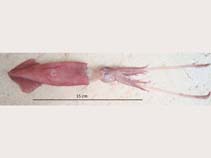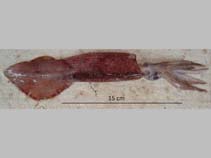Doryteuthis pleii (Blainville, 1823)
Slender inshore squid| Native range | All suitable habitat | Point map | Year 2050 |

|
| This map was computer-generated and has not yet been reviewed. |
| Doryteuthis pleii AquaMaps Data sources: GBIF OBIS |
Classification / Names Common names | Synonyms | CoL | ITIS | WoRMS
Cephalopoda | Myopsida | Loliginidae
Environment: milieu / climate zone / depth range / distribution range Ecology
Pelagic; depth range 0 - 370 m (Ref. 275), usually 20 - 75 m (Ref. 275). Tropical; 35°N - 36°S, 98°W - 34°W (Ref. 275)
Distribution Countries | FAO areas | Ecosystems | Occurrences | Introductions
Western Atlantic: New Jersey to Rio Grande do Sul.
Length at first maturity / Size / Weight / Age
Maturity: Lm ?, range 6 - 14.11 cm Max length : 35.0 cm ML male/unsexed; (Ref. 275); 22 cm ML (female)
Minimum depth from Ref. 83938. Epipelagic (Ref. 110525). Found in coastal and shelf waters down to 370 m (Ref. 843). In continental shelf (Ref. 110525).
Life cycle and mating behavior Maturity | Reproduction | Spawning | Eggs | Fecundity | Larvae
Members of the class Cephalopoda are gonochoric. Male and female adults usually die shortly after spawning and brooding, respectively. Mating behavior: Males perform various displays to attract potential females for copulation. During copulation, male grasp the female and inserts the hectocotylus into the female's mantle cavity where fertilization usually occurs. Life cycle: Embryos hatch into planktonic stage and live for some time before they grow larger and take up a benthic existence as adults (Ref. 833).
Main reference
References | Coordinator | Collaborators
Roper, C.F.E., M.J. Sweeney and C.E. Nauen. 1984. (Ref. 275)
IUCN Red List Status (Ref. 130435)
Least Concern (LC) ; Date assessed: 02 July 2015
CITES status (Ref. 108899)
Not Evaluated
CMS (Ref. 116361)
Not Evaluated
Threat to humans
Human uses
Fisheries: commercial
| FishSource |
Tools
More information
Internet sources
BHL | BOLD Systems | CISTI | DiscoverLife | FAO(Publication : search) | Fishipedia | GenBank (genome, nucleotide) | GloBI | Gomexsi | Google Books | Google Scholar | Google | PubMed | Tree of Life | Wikipedia (Go, Search) | Zoological Record
Estimates based on models
Preferred temperature
(Ref. 115969): 21 - 27.8, mean 25.4 (based on 512 cells).




